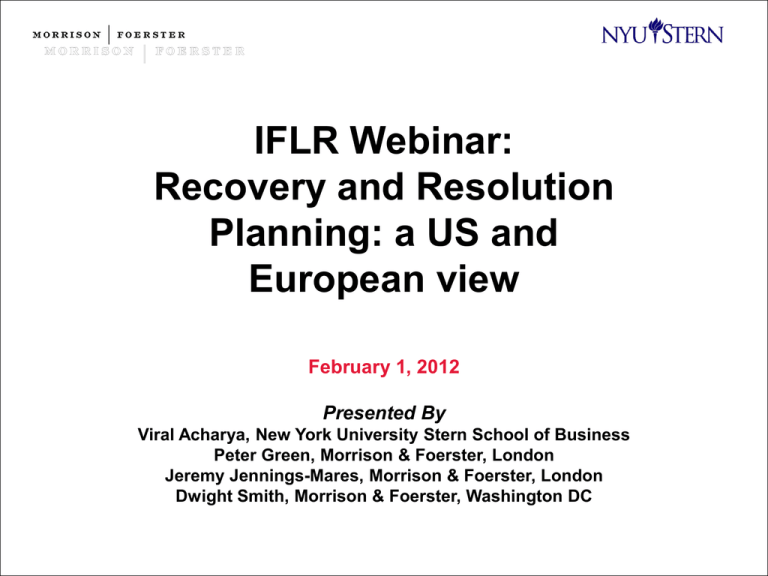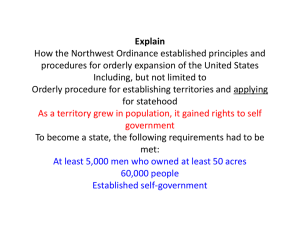recovery and resolution planning: a US and European view
advertisement

IFLR Webinar: Recovery and Resolution Planning: a US and European view February 1, 2012 Presented By Viral Acharya, New York University Stern School of Business Peter Green, Morrison & Foerster, London Jeremy Jennings-Mares, Morrison & Foerster, London Dwight Smith, Morrison & Foerster, Washington DC LN2-9566 Topics 1. 2. 3. 4. Overview of the E.U. and U.K. planning regimes European requirements U.S. requirements Does resolution planning address systemic risk? 2 G20 Commitments G20 Summit in Cannes in November 2011 endorsed implementation of 3 policy measures proposed by Financial Stability Board/Basel Committee to address risks to global financial system from systemically important financial institutions (SIFIs), particularly in respect of Global SIFIs Key Attributes of Effective Resolution Regimes for Financial Institutions Assessment Methodology and Additional Loss Absorbency Requirements for G-SIFIs Progress Report on Intensity and Effectiveness of SIFI supervision 3 FSB – Key Attributes of Effective Resolution Regimes Each jurisdiction: to have designated resolution authorities with a broad range of powers to intervene and resolve a non-viable institution (incl. business transfers, creditorfinanced recapitalisations (or bail-in of debt)), which can allocate losses to shareholders and unsecured/ uninsured creditors in their order of seniority to remove impediments to cross-border co-operation and provide national resolution authorities with mandates and incentives to share information crossborder to ensure RRP’s put in place for all G-SIFIs, regularly reviewed and updated and with annual assessments by authorities of feasibility of resolution strategies for each G-SIFI to maintain crisis management groups for all G-SIFIs, to bring together home and host competent authorities, by means of cross-border co-operation agreements. 4 Overview – Europe Expected European Commission Legislative Proposals Recovery Planning Early Intervention Options Objectives and Principles of Resolution Resolution Tools and Powers Ancillary Powers Recovery and Resolution Plans 5 Overview – UK FSA Consultation on Recovery and Resolution Planning Recovery Plan Options and Principles Resolution Plan Objectives Resolution Packs Resolution Tools 6 European Requirements Following various consultations on crisis management, the European Commission is expected (shortly) to publish its legislative proposals for a framework for crisis management and the recovery and resolution of banks and investment firms – expected to be in the form of a directive requiring separate implementation in each member state Each member state to designate a resolution authority for its jurisdiction, that authority then empowered to exercise resolution powers and apply the “resolution tools” Each member state to require each institution in its jurisdiction to draw up a recovery plan, setting out possible measures it could take to address a serious deterioration of its financial condition, risking its non-viability Group recovery plans for financial groups to be prepared by parent undertaking and submitted to consolidated supervisor, as well as individual plans for group members 7 European Requirements (cont.) Group entities to be permitted to enter into reciprocal advance agreements to provide financial support (loans, guarantees, asset transfers) to other group members in financial stress – subject to shareholder approvals Resolution authorities to have early intervention powers when institution fails, or is likely to fail, to meet its obligations under Capital Requirements Directive e.g. power to direct institution’s management to implement one or more of the measures in the recovery plan, to direct convening of shareholders’ meetings, preparation of a plan to negotiate a debt restructuring with creditors, or appoint a special manager to assume powers of management to restore financial health of the institution Resolution authorities to assess “resolvability” (without access to public funds), and to be given broad powers to remove impediments to resolvability if not remedied by the institution 8 European Requirements – Resolution Objectives of resolution: ensure continuity of basic banking functions minimise adverse effects on financial stability minimise reliance on public sector support protect depositors protect client funds and assets • No one objective automatically considered more important, and resolution authorities to have the ability to balance the weightings of the objectives as circumstances require 9 European Requirements – Resolution (cont.) Resolution triggers to be conformed across member states and will require determination by resolution authority (or national supervisor, if different): of institution’s failure or likely failure that there is no reasonable prospect of preventing failure, e.g. by private sector involvement or other supervisory action, except by resolution action that resolution action is necessary in the public interest Determination of Failure/Likely Failure if there are objective grounds to conclude that the institution: is/will be in breach of its minimum capital requirements and has/will have incurred losses too great to be absorbed by its own funds is/will be insolvent on balance sheet test or on cashflow test requires extraordinary public support in order to avoid one of the above 10 European Requirements – Principles of Resolution Resolution authorities to be required to observe the following principles when taking resolution action: shareholders/creditors bear “appropriate” shares of losses senior management is replaced and bear losses in proportion to their culpability creditors of the same class are treated equitably and do not incur greater losses than they would in a winding-up Valuation of assets/ liabilities to be carried out by valuer independent from institution/ resolution authority 11 European Requirements – Tools and Powers Sale of business tool – power to transfer shares or assets/liabilities, or a combination, to a purchaser on commercial terms without shareholder approval Bridge bank tool – power to transfer some or all assets/liabilities of the institution to a publicly-owned bridge bank, without shareholder approval, to be held temporarily with a view to returning those assets, or the bridge bank, to the private sector (both of the above options exercisable free from any company law/securities law constraints) Asset separation tool – power to transfer assets/liabilities to a publicly-owned asset management vehicle, to maximise their value for eventual sale Debt write-down tool – power to write down or write off debt and/or to convert debt obligations into ordinary shares 12 European Requirements – Ancillary Powers Ancillary to the main tools and powers, resolution authorities are to have power to: make any transfers free from encumbrances/pre-emption rights de-list any instrument provide for recipient of any transfer to step into the shoes of the institution in resolution, in respect of any contracts or arrangements provide for the institution under resolution to provide assistance/information to the recipient modify, cancel or novate any contract entered into by the institution provide for business continuity arrangements, such as continuity of contracts entered into by the institution 13 European Requirements – Ancillary Powers (cont.) Member states must give effect to any transfer, by a resolution authority of another member state, of assets/liabilities in their jurisdiction and must ensure that: no creditors or third parties have the ability to prevent or set aside such transactions under the laws of their jurisdiction and any use of the debt write-down tool becomes effective in respect of instruments governed by the laws of their jurisdiction Resolution authorities to be able to: suspend payment/delivery obligations under contracts of the institution suspend rights to enforce security interests suspend for a short period the exercise of termination rights under “financial contracts” e.g. derivatives, repos 14 European Requirements – Ancillary Powers (cont.) Resolution authorities will be able to prevent parties to financial contracts exercising termination rights: where the contract has been transferred to a purchaser/bridge bank which has assumed the institution’s rights and obligations thereunder where debt has been written down/converted under the debt-write down tool, but not the debt owing under that financial contract In those circumstances, they would also be able to prevent the use of reliance on a clause which would otherwise modify the counterparties’ obligations (e.g. Section 2(a)(iii) ISDA Master Agreement) 15 European Requirements – Ancillary Powers (cont.) Set-off rights of the counterparty would not be exercisable against a purchaser/bridge bank to which the counterparty’s claims under a contract have been transferred, and in the case of a debt write down or conversion, would be extinguished to the extent of the write-down conversion 16 European Requirements – Contents of Recovery Plans Identification of critical functions Capital and liquidity actions required to maintain and fund operations of critical functions and business lines Arrangements to conserve/restore the institution’s own funds Arrangements to ensure adequate access to contingency funding sources Arrangements to reduce risk and leverage and to restructure liabilities Arrangements to restructure business lines Arrangements to maintain continued access to financial market infrastructure and functioning of IT services and other firm infrastructure Estimate of timeframe for achieving each material part of the plan Description of obstacles to effective execution of the plan 17 European Requirements – Resolution Planning Resolution authorities can demand various information from institutions for the purpose of drawing up and maintaining resolution plans: legal/operational structures of the institution or its group mapping of business activities to the entities which perform them critical economic functions within the group, mapped to business lines for each critical economic function, details of market share, relevant balance sheet information, number and location of customers infrastructure supporting critical economic functions e.g. staff, real property, contracts, licences intra-group exposures and exposures to counterparties e.g. hedging liabilities, collateral pledged intra-group contracts and guarantees 18 European Requirements – Resolution Planning (cont.) Proportionality to be applied by member states to contents of resolution plans, information able to be requested and measures demanded to remove obstacles to resolvability Information for group resolution plans to be submitted to group-level resolution authority (for parent and for all legal entities part of the regulatory group) Group resolution authority will share information with EBA and resolution authorities of subsidiaries Group resolution plan to be jointly decided on by all authorities 19 UK Progress FSA consultation on Recovery and Resolution Plans in August 2011 Provisions intended to take effect in Q1 2012, with preparation of RRPs by June 2012 Applicable to banks and “full service” investment firms with assets of at least £15bn, not applicable to UK branches of foreign banks Recovery plans to be developed and maintained, containing: comparative summary of the credible options to cope with various scenarios, both institution-specific and group specific, but also market-wide stress options to address capital shortfalls/liquidity pressures and return the firm to a stable, sustainable position appropriate governance processes, including conditions/procedures for intervention to ensure prompt implementation of recovery options 20 UK Progress (cont.) details of how implementation of the recovery plan fits within the firm’s existing risk management framework explanation of the triggers that would indicate when the plan should be invoked list of key executives who would be involved in each recovery action, and their roles a communication plan (internal and external) to accompany the recovery options, aiming to manage doubts over viability of the firm and preserve confidence of market 21 UK Progress – Recovery Plans Likely recovery plan options include: disposals of assets/businesses raising additional unplanned–for equity capital ceasing payments of dividends, variable remuneration and other discretionary distributions debt exchanges/other liability management action sale of whole firm to a third party plans to access central bank facilities Proportionality – smaller firms likely to have fewer options, therefore simpler plans Recovery options must not prioritise short-term remedial actions over long-term viability 22 UK Progress – Recovery Plans (cont.) Options must meet following minimum criteria: benefits of options to be capable of being realised within acceptable timeframe (no more than 6 months?) benefits to be sufficiently material – must make a significant impact on financial health should be sufficiently diverse to cope with both idiosyncratic and market-wide stress events must be credible to stakeholders – depositors, debt holders, counterparties, shareholders, authorities 23 UK Progress – Resolution Planning Firms to provide information in Resolution Pack to FSA (and PRA), Treasury and Bank of England Authorities to prepare resolution plan with following aims: ensure resolution without public support minimise impact on financial stability minimise effect on depositors/consumers allow decisions/action to be taken over a “resolution weekend” identify those economic functions whose continuity critical to the economy/financial system and those required to be wound up in an orderly fashion identify/remove barriers to resolution for G-SIFIs, enhance international co-operation and crisis management planning between international regulators 24 UK Progress – Resolution Packs Group structure and legal information: overall group structure diagram, showing significant legal entities, the group’s approach to use of branches vs. subsidiaries in different jurisdictions and an idea of business done in each branch/sub high-level understanding of the economic functions performed within, or in some way dependent on, each significant legal entity and the scale of those activities breakdown of group balance sheet by significant legal entity, including details of committed capital and requirements/restrictions by regulatory jurisdiction understanding of major financial dependencies between legal entities as they affect funding and capital (e.g. intra-group guarantees, cross funding, cash sweeping, cross-defaults) understanding of the firm’s inter connectedness with other banks for significant UK legal entities (and any non-UK legal entities that provide major services to UK economy, details of operational dependencies (shared IT, premises etc), shared staffing etc 25 UK Progress – Resolution Packs (cont.) Economic functions, e.g. payment services to facilitate “real economy” transactions intermediation of credit and capital to allow “real economy” participants to save, invest and borrow efficiently risk management products and services, to facilitate risk pooling and protect “real economy” participants against adverse events For each economic function: key metrics to help understand the scale of each economic function, such as number of customers, market shares, balance sheet/P&L items attributable to the economic function high level commentary on the impact of potential closure of the economic function e.g. whether there is sufficient market capacity to fill the gap caused by the closure key metrics for economic functions outside the UK, run through foreign branches of UK entities explanation of which legal entity/entities the economic function sits in (and alongside which other economic functions) 26 UK Progress – Resolution Packs (cont.) Each UK critical economic function to have a contingency analysis (CFCA), analysing how that particular critical function can be separated, while either preserving its continuity or preparing for its orderly winding down Analysis would be used to allow the firm to identify barriers to a resolution over a weekend, and ways to deal with the barriers Will lay out key steps required to unplug the economic function, ready for a transfer Authorities will then discuss with the firm actions to address any significant resolution barriers identified and the costs of these actions 27 UK Progress – Resolution Tools Transfer to private sector purchaser – Banking Act 2009 Transfer to publicly-owned bridge bank – Banking Act 2009 Debt-write down/ bail-in able debt proposed in ICB Report primary and secondary bail-in powers ICB acknowledgement that bail-in needs international agreement to be fully effective Difficulties in relation to foreign law contracts, contracts with crossdefault/ termination provisions etc. 28 U.S. Requirements 29 Overview – U.S. So if you are a big bank or financial institution, you’re no longer allowed to make risky bets with your customers' deposits. You're required to write out a "living will" that details exactly how you'll pay the bills if you fail – because the rest of us are not bailing you out ever again. President Obama State of the Union Address Jan. 24, 2012 30 Overview – U.S. Purpose of the resolution plan “Orderly” resolution through existing bankruptcy process Avoidance of Lehman Brothers experience Roadmap for liquidation through orderly liquidation authority Resolution planning is integrated with other Dodd-Frank requirements Capital planning Stress testing Credit exposure reports 31 Overview – U.S. Requirements apply to “covered companies:” U.S. bank holding companies with more than $50 billion in consolidated assets Nonbank financial companies designated by the Financial Stability Oversight Council Foreign banking organizations with more $50 in worldwide consolidated assets Three tiers of institutions and timing requirements July 21, 2012: covered companies with more than $250 billion in total nonbank assets. For foreign-based covered companies, threshold is $250 billion U.S. total nonbank assets July 21, 2013: covered companies with more than $100 billion in total nonbank assets. For foreign-based covered companies, $100 billion in U.S, nonbank assets December 31, 2013: all other covered companies Separate planning requirement at bank level for banks with more than $50 billion in consolidated assets 32 Overview – U.S. Plan for “rapid and orderly resolution in the event of material financial distress or failure.” How insured depository institution subsidiaries are protected from risks arising from activities of nonbank affiliates Full description of ownership structure, assets, liabilities, and contractual obligations Identification of cross-guarantees tied to different securities, identification of major counterparties, and a process for determining to whom the collateral of the company is pledged Dodd-Frank Act § 165(d); 12 USC 1851(d) 33 Plan Content Scope of DFA Plan “Rapid and orderly resolution” Using the bankruptcy process to achieve that result FBOs: Scope of the DFA Plan is limited to the resolution of entities based in the U.S. FRB and FDIC review of an FBO’s DFA Plan will include consideration of “[t]he nature and extent of the home country’s related crisis management and resolution planning requirements.” A DFA Plan for an FBO with limited assets or operations in the U.S. “would be significantly limited in scope and complexity.” 34 Plan Content Access to liquidity Corporate governance structure and related policies and procedures Credit/derivative exposures (domestic and worldwide) Organizational structure and entity-specific functions Core business lines On- and off-balance sheet exposures Core management and employees Interrelationships between corporate entities Management information systems 35 Plan Content Content: Eight Minimum Requirements for DFA Plans (generally) 1. An executive summary describing key elements of the strategic plan for rapid and orderly resolution in the event of material financial distress 2. A strategic analysis describing the plan for rapid and orderly resolution, including a range of specific actions that would be taken, and a description of the funding, liquidity, and capital needs of the filing institution and its material entities 3. A detailed description of corporate governance related to resolution planning, including how resolution planning is integrated into the corporate governance structure of the covered company 4. A detailed description of organizational structure and related information, including lists of all material entities, a mapping of the covered company’s critical operations and core business lines, and identification of major counterparties of the covered company 36 Plan Content Minimum Requirements for DFA Plans (continued) 5. A detailed description of management information systems, including a detailed inventory and description of systems and applications for risk management, accounting, and financial regulatory reporting, and a mapping of key management information systems to the material entities, critical operations and core business lines of a covered company 6. If not provided elsewhere, an identification and mapping to the material entities of the interconnections and interdependencies among the covered company and its material entities, including common or shared personnel, capital, funding, or liquidity arrangements 7. Identification of supervisory and regulatory information, including U.S. and foreign agencies or authorities, along with relevant contact information 8. Contact information for a senior management official responsible for serving as a point of contact regarding the resolution plan 37 Plan Content Certain institutions may be eligible to file a “tailored” DFA Plan. The tailored plan option is available only to Covered Companies that are bank holding companies that have less than $100 billion in total nonbank assets (Group 3), and whose IDI assets comprise at least 85 percent of the total consolidated assets of the Covered Company. Foreign-based Covered Companies are eligible if (i) total U.S. nonbanking assets are less than $100 billion, and (ii) the assets of any U.S. IDI operations, branches and agencies constitute 85% or more of the company’s U.S. total consolidated assets. Of the 124 Covered Companies, 104 would currently be eligible to file a tailored plan. 38 Plan Content Tailored Plans (continued) Tailored plans focus more on the nonbanking operations and business lines subject to the U.S. Bankruptcy Code, and the interconnections between the nonbanking operations and the IDI. Tailored plans are intended to reduce informational and analytical burden on majority of filing institutions. The practical effect, however, is unclear as IDI Plans will still need to be filed along with tailored plans. FBOs that do not control an IDI chartered in the U.S. should receive the greatest benefit from the tailored plan option. 39 Agency Review “Credible Plans” – DFA and IDI Plans must be “credible.” For purposes of the IDI Plan, the FDIC explains that a plan is credible if: Resolution strategies are well-founded and based on observable or verifiable conditions. Detailed information required is verifiable. The plan employs reasonable projections from current and historical conditions within the broader financial markets. There is no similar provision in the DFA Plan. FRB and FDIC acknowledge there is no “one-size-fits-all” approach. FRB and FDIC will consider variances in core business lines, critical operations, foreign operations, capital structure, risk, complexity, financial activities (including the financial activities of their subsidiaries), size, and other relevant factors. 40 Agency Review Consequences of deficient Plans Underlying principle: iterative process and deficiencies can be remedied If deficiencies are not remedied, FRB and the FDIC may: Impose additional capital, leverage, or liquidity requirements Restrict the growth, activities, or operations of the covered company or its subsidiaries Jointly require divestiture of assets or operations as necessary to facilitate orderly resolution under the Bankruptcy Code, if a covered company fails to remedy a deficient plan within two years of having been subjected to such requirements or restrictions Foreign regulators may be consulted in this circumstance. 41 Related Dodd-Frank Requirements Work on a DFA Plan must take into account other Dodd-Frank requirements and agency actions. Credit exposure (Dodd-Frank § 165) New rule on credit exposures to be issued by FRB Final rule on reports to be coordinated with rule on credit exposures Interagency guidance released June 29, 2011 (S&R Letter 11-10) Stress testing (§ 165(i)) Proposed guidance for banking organizations with more than $10 billion in consolidated assets, including foreign banking organizations. (76 FR 35072 (June 15, 2011)) Proposed annual capital plans for U.S.-domiciled “top-tier” bank holding companies, issued June 17, 2011 (76 FR 35351) Proposed new FR Y-14A, -14Q reports (76 FR 555288 (Sept. 7, 2011) Included in proposal on enhanced prudential standards (77 Fed. Reg. 594 (Jan. 5, 2012) 42 Related Dodd-Frank Requirements Other Dodd-Frank requirements and agency actions (cont’d) Capital requirements Contingent capital (§ 165(c)) Collins amendment (§ 171) Basel III Inclusion of off-balance sheet assets (§ 165(k)) Countercyclical requirements (§ 616) Required restructuring Volcker Rule (§ 619) Lincoln Amendment (§ 716) 43 Overlapping Compliance Other Dodd-Frank requirements and agency actions (cont’d) Early remediation (§ 166) No proposed rule yet Various remedies could mirror resolution plan elements Orderly Liquidation Authority (Title II) Preventing agency findings that would trigger OLA Roadmap for FDIC Public disclosures (§ 165(f)) Short-term debt limits (§ 165(g)) Risk committee (§ 165(h)) Leverage limits (§ 165(j)) Inclusion of off-balance sheet assets in capital calculations (§ 165(k)) 44 Annual Planning Cycle Oct. 1: company begins to collect financial information as of Sept. 30. Mid-November: company submits regulatory reports to FRB; FRB supplies stress test scenarios Mid-November to year end: company conducts internal stress tests, prepares capital plan and resolution plan Dec. 31: company submits annual resolution plan Jan. 5: company submits capital plan and stress test results Early March: FRB communicates its stress test results to company March 31: FRB responds to capital plan; company has 30 calendar days in which to revise plan. Mid-April: Results of company and FRB stress tests published. 45 FBOs Purpose of plan for US regulators DFA Plan submitted by an FBO needs to comply with the minimum required content discussed above, while also addressing: U.S. subsidiaries, branches, agencies and operations How resolution planning for its U.S. operations is integrated into the FBO’s overall resolution or other contingency planning process Interconnections and interdependencies among its U.S. operations and its foreign-based operations 46 FBOs (cont.) Regulators will “give due regard to the principle of national treatment and equality of competitive opportunity” and take into account the regulatory standards for consolidated supervision by the homecountry regulator. A possible mechanism to satisfy this “due regard” requirement is the Crisis Management Group (CMG) that the FSB has discussed. Each Covered Company would have its own CMG, which would consist of representatives of all of the jurisdictions in which the Covered Company had operations and would be led by the homecountry supervisor. 47 Cross-border Issues DFA and IDI Plan submissions should be synchronized with resolution plan deadlines and requirements imposed by foreign regulators. Specific deadlines may differ. Foreign regulators may require submissions in 2012 by U.S. Group 2 institutions. UK Financial Services Authority: proposed initial submissions are due June 2012. Financial Services Board: first drafts of recovery plans are due by December 2011, and first drafts of resolution plans by June 2012. 48 International Materials Foreign developments Financial Stability Board Consultative document (July 19, 2011) Key Attributes of Effective Resolution Regimes for Financial Institutions (Oct. 2011) Progress Report on Intensity and Effectiveness of SIFI Supervision (Nov. 2011) Financial Services Authority Consultation Paper—CP 11/16 (Aug. 9, 2011) Turner Review (Mar. 2009) Independent Commission on Banking (Vickers Commission) Final Report (Sept. 2011) Basel Committee on Banking Supervision Final Report of Cross-border Bank Resolution Group (Mar. 2010) Progress Report (July 2011) Assessment Methodology and Additional Loss Absorbency for G-SIBs (Nov. 2011) G20 Communiqué (Oct. 14-15, 2011) Identification of G-SIBs (Nov. 2011) 49 RESOLUTION AUTHORITY Presentation based on Chapter 8, “Resolution Authority”, by Acharya, Adler, Richardson and Roubini Chapter 11 “Repo Markets”, by Acharya and Oncu “A Proposal to Resolve the Distress of Large, Complex Financial Institutions”, By Acharya, Adler and Richardson 50 An Important Ongoing Debate What is “systemic risk”? Macro-prudential view: Common factor exposures Several entities fail together Micro-prudential view: Contagion Failure of an entity leads to distress or failures of others The two views are not mutually exclusive However, much regulatory reform takes one view or the other The Dodd-Frank Act is primarily the “micro-prudential view” 51 Resolution Authority under the Act Hangs its hat on the creation of Orderly Liquidation Authority (OLA) Balancing act between two forces that (potentially) work against each other Mitigate moral hazard, bring back market discipline Manage systemic risk How well does the Dodd-frank do? We summarize briefly four problem areas We discuss a macro-prudential resolution approach (repos) 52 Four Problems with Dodd-Frank OLA 1. Focused on the orderly liquidation of an individual institution and not the system as a whole. Passing losses to SIFI creditors wipes out capital of other SIFIs Need an ex-ante Orderly Liquidation Fund (OLF) 2. If the system fails, and monies cannot be recovered from creditors, surviving SIFIs must make up the difference ex post. Increases moral hazard because of a free rider problem. Increases systemic risk as reduces incentives to deviate from the herd. 53 Problems with Dodd-Frank OLA (cont.) 3. Restricts the Fed’s 13(3) LOLR ability to deal with nonbanks unless a system wide crisis emerges If we have multiple failures, how will an OLA deal with it? OLA and funeral plans fail the first time they are tried out… No emergency fire service just because we have sprinklers?! 4. Is receivership the right approach in systemic crisis? Prompt corrective action and “living wills” helpful Ability to set up a “bridge bank” helpful Who will run the bridge bank? What is the likelihood a bridge bank will be required for a firm? Who will fund its operations? 54 Fix I: Living Will Approach (Academic concept of) “Living will” - Barry Adler, NYU Law Divide a firm’s capital structure into priority tranches In the event of a default, equity would be eliminated, and lowest-priority debt tranche would be converted to equity If this is isn’t sufficient, the process is repeated until all defaults are cured or the highest tranche is converted to equity. Only at this point would senior debt-holders have reason to foreclose on collateral. Creditors pay but the cost of financial distress is avoided. Issues like “what is the trigger?” and “what happens if the living will can’t stop the collapse or contagion?” remain. “Bail-in” is akin to living will, but iterates just once… 55 Fix II: Macro-prudential Resolution Systemically important liabilities Financier of a SIFI is another SIFI, an entity that is run-prone, or whose run will likely trigger more runs Financial firms are each other’s creditors Each firm’s equity has value from credit claim on other firms Loss to capital of one firm erodes the capital of other firms Individually, firms do not internalize this externality System as a whole must put up capital to deal with failures on systemically important liabilities Charge as per each firm’s contribution E.g. NYU Stern Systemic Risk Rankings For other liabilities, use bail-in or “living will” approach 56 Resolution Method Proposed by How are systemic liabilities dealt with? Pros Cons Orderly Liquidation Authority (OLA) Dodd-Frank Act, FDIC Pass on losses; Can use Orderly Liquidation Fund Deals with incentives Does not deal with systemic risk / contagion Contingent capital Flannery; Squam Lake Report Protected through CoCo’s that convert to equity Creates time for orderly resolution What next? Does not spell out resolution Bail-in / Living will Credit Suisse; Adler Progressive losses that are pre-programmed Spells out an orderly resolution Adequate to deal with contagion? Automatic stabilizers + Bail-in Acharya, Adler, Richardson Deposit insurance, repo resolution authority, CCPs, LOLR, …, Bail-in Pre-arranges system-wide capital for resolution Requires capital mgt at DI Fund, CCH,… 57 International Coordination of SIFI Resolution 1. Identify classes of Systemically Important Liabilities (deposits, repos, derivatives, SIFI exposures) 2. Require living-will (sequential bail-in) on non-SIL debt; harmonize on living-will for non-SIL debt SIL debt: 1. Ensure DI funds are pre-funded, counter-cyclically 2. Create system-wide resolution authorities for other SIL’s 3. Standards for initial and variation/stress-margin requirements at clearinghouses; manage their risks 4. Require central banks to spell out a priori eligible collateral for LOLR and charge for these liquidity facilities 58 Contacts Viral Acharya C.V. Starr Professor of Economics NYU Stern School of Business vacharya@stern.nyu.edu Peter Green Partner, London Morrison & Foerster (UK) LLP pgreen@mofo.com Dwight Smith Partner, Washington DC Morrison & Foerster LLP dsmith@mofo.com Jeremy Jennings-Mares Partner, London Morrison & Foerster (UK) LLP jjenningsmares@mofo.com 59










